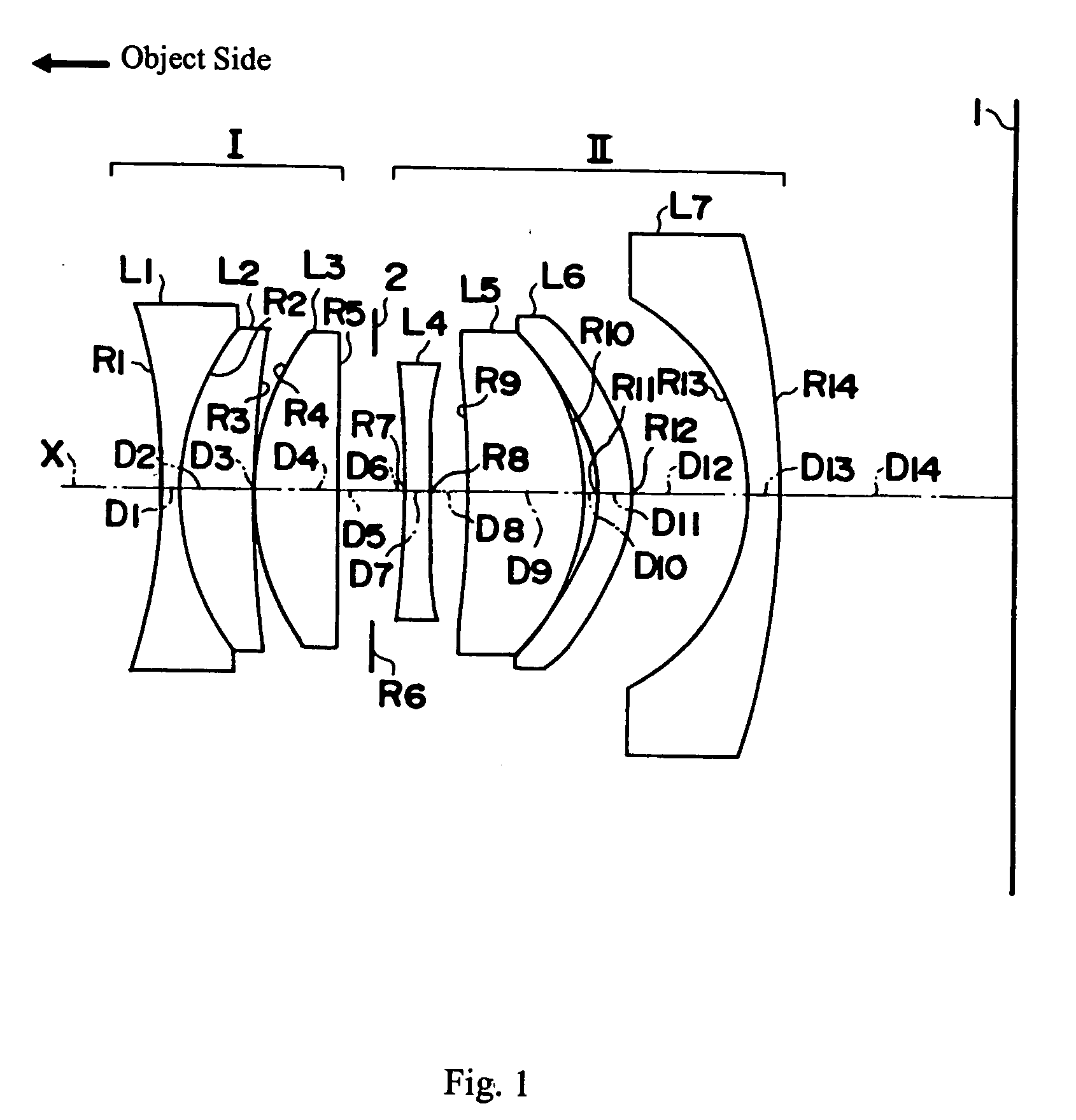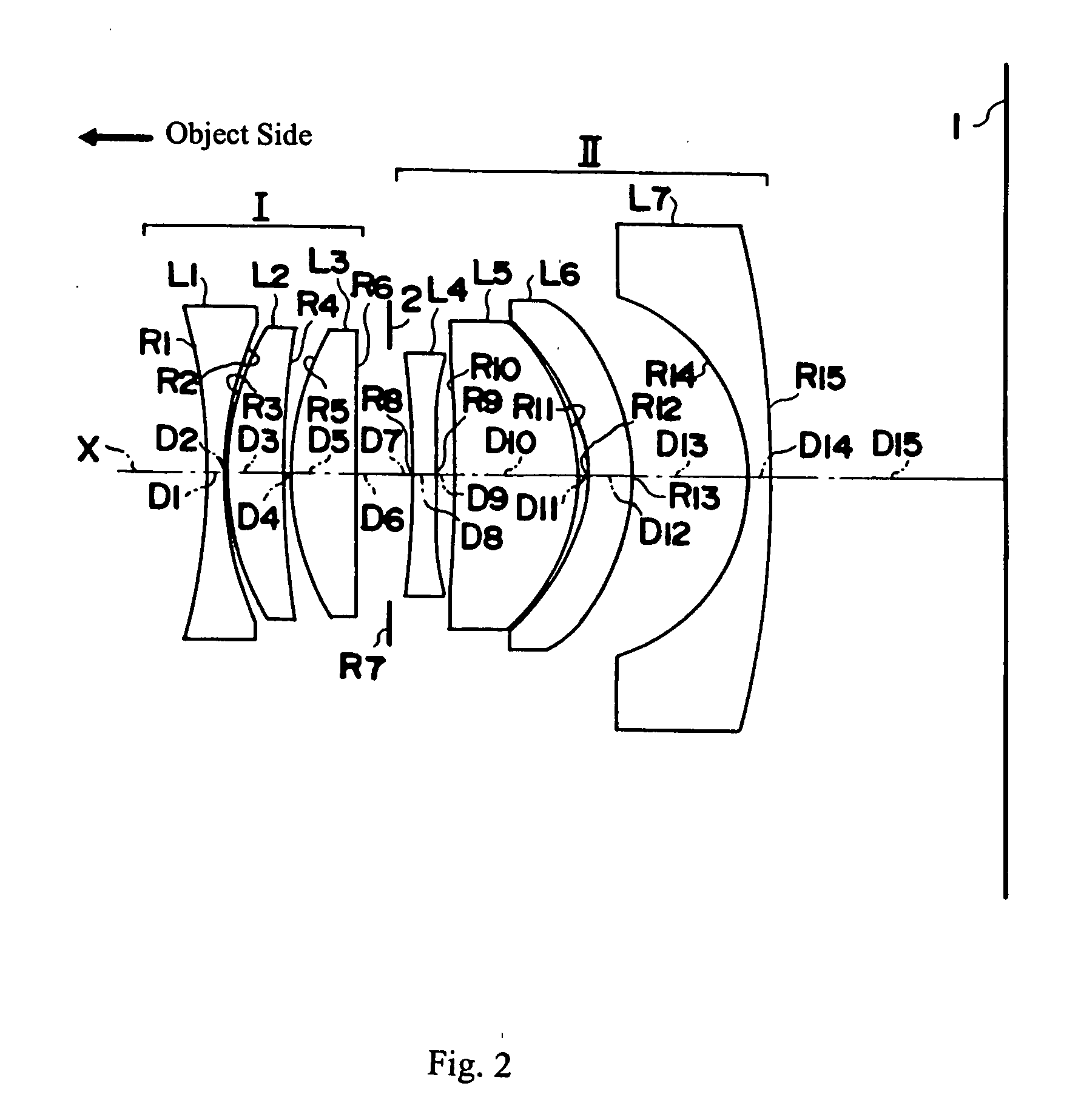Large aperture wide-angle lens and camera including large aperture wide-angle lens
a large aperture, wide-angle lens technology, applied in the field of compact large-angle wide-angle lenses, can solve the problems of difficult continuous imaging in order to secure the time required for stroboscopic exposure, inability to produce images as bright as those seen by the human eye, and inability to produce bright images. bright, the effect of small lens diameter, short back focus
- Summary
- Abstract
- Description
- Claims
- Application Information
AI Technical Summary
Benefits of technology
Problems solved by technology
Method used
Image
Examples
embodiment 1
[0047]FIG. 1 shows a cross-sectional view of the large aperture wide-angle lens of Embodiment 1 of the present invention. As shown in FIG. 1, the large aperture wide-angle lens of Embodiment 1 includes, in order from the object side, the first lens group I, the stop 2, and the second lens group II. In order from the object side, the first lens group I includes three lens elements, L1, L2, and L3, and the second lens group II includes four lens elements, L4, L5, L6, and L7. A luminous flux that enters from the object side is efficiently focused on an image plane 1 of FIG. 1, where a photographic film may be located.
[0048] Within the first lens group I, the first lens element L1 is a biconcave lens element with an image-side surface of greater curvature; the second lens element L2 is a meniscus lens element having positive refractive power, having a convex object-side surface, and joined with the first lens element L1 to form a lens component; and the third lens element L3 is a bicon...
embodiment 2
[0057]FIG. 2 shows a cross-sectional view of the large aperture wide-angle lens of Embodiment 2 of the present invention. Embodiment 2 is very similar to Embodiment 1 and uses the same number of lens elements. However, Embodiment 2 differs from Embodiment 1 in that in Embodiment 2, lens elements L1 and L2 are separate lens components rather than joined as one lens component as in Embodiment 1, and Embodiment 2 also differs from Embodiment 1 in that in Embodiment 2, lens element L3 is a meniscus lens element with the convex surface on the object side rather than a biconvex lens element as in Embodiment 1 (but lens element L3 has positive refractive power in both Embodiments 1 and 2).
[0058] Table 4 below lists the surface number # in order from the object side, the radius of curvature R (in mm) of each surface on the optical axis, the on-axis surface spacing D (in mm), as well as the refractive index Nd and the Abbe number νd (both at the d-line of 587.6 nm) of each optical element f...
embodiment 3
[0065]FIG. 3 shows a cross-sectional view of the large aperture wide-angle lens of Embodiment 3 of the present invention. Embodiment 3 is similar to Embodiment 1 and uses the same number of lens elements and lens components. However, Embodiment 3 differs from Embodiment 1 in that in Embodiment 3, lens element L3 is a meniscus lens element with the convex surface on the object side rather than a biconvex lens element as in Embodiment 1 (but lens element L3 has positive refractive power in both Embodiments 1 and 3). Additionally, Embodiment 3 differs from Embodiment 1 in that in Embodiment 3, lens element L5 is a biconvex lens element rather than a meniscus lens element as in Embodiment 1 (but the image-side surface has greater curvature in both Embodiments 1 and 3), and Embodiment 3 differs from Embodiment 1 in that in Embodiment 3, lens element L7 is a biconcave lens element rather than a meniscus lens element as in Embodiment 1 (but the object-side surface has greater curvature in ...
PUM
 Login to View More
Login to View More Abstract
Description
Claims
Application Information
 Login to View More
Login to View More - R&D
- Intellectual Property
- Life Sciences
- Materials
- Tech Scout
- Unparalleled Data Quality
- Higher Quality Content
- 60% Fewer Hallucinations
Browse by: Latest US Patents, China's latest patents, Technical Efficacy Thesaurus, Application Domain, Technology Topic, Popular Technical Reports.
© 2025 PatSnap. All rights reserved.Legal|Privacy policy|Modern Slavery Act Transparency Statement|Sitemap|About US| Contact US: help@patsnap.com



